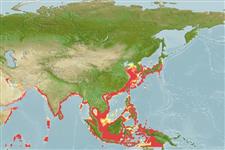Common names from other countries
Environment: milieu / climate zone / depth range / distribution range
Ecologie
Pelagisch; brakwater; diepteverspreiding 1 - 100 m (Ref. 101307). Tropical, preferred 23°C (Ref. 107945); 41°N - 11°S, 47°E - 142°E
Indo-West Pacific.
Length at first maturity / Size / Gewicht / Leeftijd
Maturity: Lm 1.8, range 2 - 1.8 cm Max length : 2.4 cm BL mannelijk/geslacht niet bekend; (Ref. 409); 3 cm BL (female)
Phyto- and zooplanktivorous (Ref. 128452). Epipelagic, inhabits shallow coastal waters over muddy bottoms (Refs. 409, 128452). Found in a mangrove vegetate area (Ref. 121475).
Members of the order Decapoda are mostly gonochoric. Mating behavior: Precopulatory courtship ritual is common (through olfactory and tactile cues); usually indirect sperm transfer.
Chan, T.Y. 1998. (Ref. 409)
Status op de Rode Lijst van het IUCN (Ref. 130435)
Status bij CITES (Ref. 108899)
Not Evaluated
Not Evaluated
Gebruik door de mens
Visserij: commercieel
FAO - Aquacultuur: production; Visserij: landings, soortsprofiel | FishSource | Sea Around Us
Tools
Internet-bronnen
Estimates based on models
Preferred temperature
(Ref.
115969): 20.5 - 29.1, mean 28.2 (based on 1684 cells).
Weerstandsvermogen
Hoog, minimale populatieverdubbelingstijd minder dan 15 maanden (K=1.3-1.8).
Prior r = 1.19, 95% CL = 0.79 - 1.79, Based on 3 data-limited stock assessments.
Kwetsbaarheid
Low vulnerability (10 of 100).
